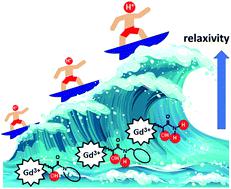当前位置:
X-MOL 学术
›
Chem. Sci.
›
论文详情
Our official English website, www.x-mol.net, welcomes your
feedback! (Note: you will need to create a separate account there.)
Acid-catalyzed proton exchange as a novel approach for relaxivity enhancement in Gd-HPDO3A-like complexes
Chemical Science ( IF 7.6 ) Pub Date : 2020-07-06 , DOI: 10.1039/d0sc02174a Loredana Leone 1, 2, 3, 4 , Mariangela Boccalon 4, 5, 6, 7 , Giuseppe Ferrauto 4, 8, 9 , István Fábián 10, 11, 12, 13, 14 , Zsolt Baranyai 4, 5, 6, 7 , Lorenzo Tei 1, 2, 3, 4
Chemical Science ( IF 7.6 ) Pub Date : 2020-07-06 , DOI: 10.1039/d0sc02174a Loredana Leone 1, 2, 3, 4 , Mariangela Boccalon 4, 5, 6, 7 , Giuseppe Ferrauto 4, 8, 9 , István Fábián 10, 11, 12, 13, 14 , Zsolt Baranyai 4, 5, 6, 7 , Lorenzo Tei 1, 2, 3, 4
Affiliation

|
A current challenge in medical diagnostics is how to obtain high MRI relaxation enhancement using GdIII-based contrast agents (CAs) containing the minimum concentration of GdIII ions. We report that in GdHPDO3A-like complexes a primary amide group located in close proximity to the coordinated hydroxyl group can provide a strong relaxivity enhancement at slightly acidic pH. A maximum relaxivity of r1 = 9.8 mM−1 s−1 (20 MHz, 298 K) at acidic pH was achieved, which is more than double that of clinically approved MRI contrast agents under identical conditions. This effect was found to strongly depend on the number of amide protons, i.e. it decreases with a secondary amide group and almost completely vanishes with a tertiary amide. This relaxivity enhancement is attributed to an acid-catalyzed proton exchange process between the metal-coordinated OH group, the amide protons and second sphere water molecules. The mechanism and kinetics of the corresponding H+ assisted exchange process are discussed in detail and a novel simultaneous double-site proton exchange mechanism is proposed. Furthermore, 1H and 17O NMR relaxometry, Chemical Exchange Saturation Transfer (CEST) on the corresponding EuIII complexes, and thermodynamic and kinetic studies are reported. These highlight the optimal physico-chemical properties required to achieve high relaxivity with this series of GdIII-complexes. Thus, proton exchange provides an important opportunity to enhance the relaxivity of contrast agents, providing that labile protons close to the paramagnetic center can contribute.
中文翻译:

酸催化质子交换作为Gd-HPDO3A类复合物弛豫增强的新方法
医学诊断中的当前挑战是如何使用含有最低浓度的Gd III离子的基于Gd III的造影剂(CA)获得高MRI弛豫增强。我们报告说,在类似GdHPDO3A的配合物中,靠近配位羟基的伯酰胺基团可以在弱酸性pH值下提供强大的弛豫性增强。在酸性pH下,最大弛豫度为r 1 = 9.8 mM -1 s -1(20 MHz,298 K),是相同条件下临床批准的MRI造影剂的两倍以上。发现该效应在很大程度上取决于酰胺质子的数量,即它在仲酰胺基团下减少,而在叔酰胺基团下几乎完全消失。这种弛豫性的提高归因于金属配位的OH基团,酰胺质子和第二球水分子之间的酸催化质子交换过程。详细讨论了相应的H +辅助交换过程的机理和动力学,并提出了新颖的同时双位质子交换机理。此外,在相应的Eu III上进行1 H和17 O NMR弛豫,化学交换饱和转移(CEST)配合物,并进行了热力学和动力学研究。这些突出显示了使用该系列的Gd III复合物实现高弛豫性所需的最佳物理化学性质。因此,质子交换提供了增强造影剂弛豫性的重要机会,条件是靠近顺磁中心的不稳定质子可以起作用。
更新日期:2020-08-05
中文翻译:

酸催化质子交换作为Gd-HPDO3A类复合物弛豫增强的新方法
医学诊断中的当前挑战是如何使用含有最低浓度的Gd III离子的基于Gd III的造影剂(CA)获得高MRI弛豫增强。我们报告说,在类似GdHPDO3A的配合物中,靠近配位羟基的伯酰胺基团可以在弱酸性pH值下提供强大的弛豫性增强。在酸性pH下,最大弛豫度为r 1 = 9.8 mM -1 s -1(20 MHz,298 K),是相同条件下临床批准的MRI造影剂的两倍以上。发现该效应在很大程度上取决于酰胺质子的数量,即它在仲酰胺基团下减少,而在叔酰胺基团下几乎完全消失。这种弛豫性的提高归因于金属配位的OH基团,酰胺质子和第二球水分子之间的酸催化质子交换过程。详细讨论了相应的H +辅助交换过程的机理和动力学,并提出了新颖的同时双位质子交换机理。此外,在相应的Eu III上进行1 H和17 O NMR弛豫,化学交换饱和转移(CEST)配合物,并进行了热力学和动力学研究。这些突出显示了使用该系列的Gd III复合物实现高弛豫性所需的最佳物理化学性质。因此,质子交换提供了增强造影剂弛豫性的重要机会,条件是靠近顺磁中心的不稳定质子可以起作用。











































 京公网安备 11010802027423号
京公网安备 11010802027423号